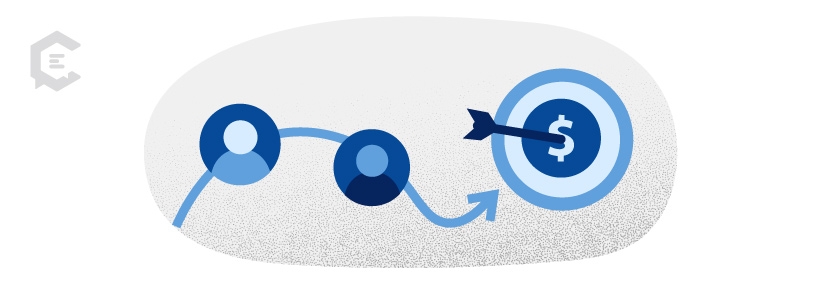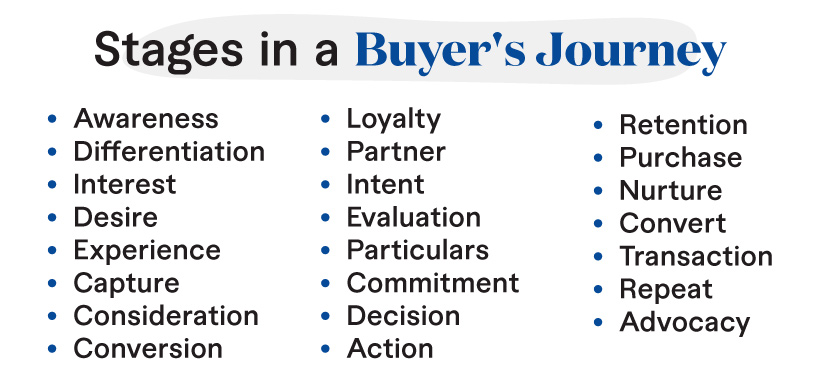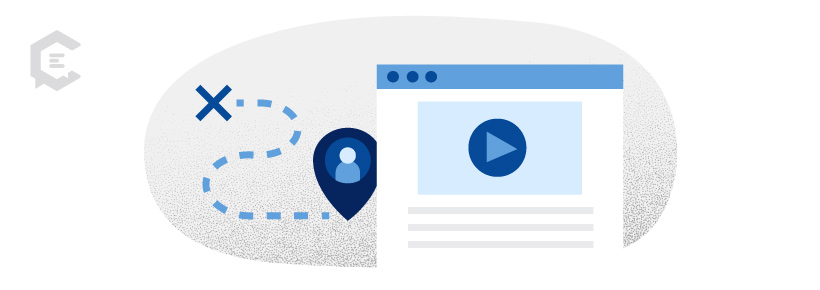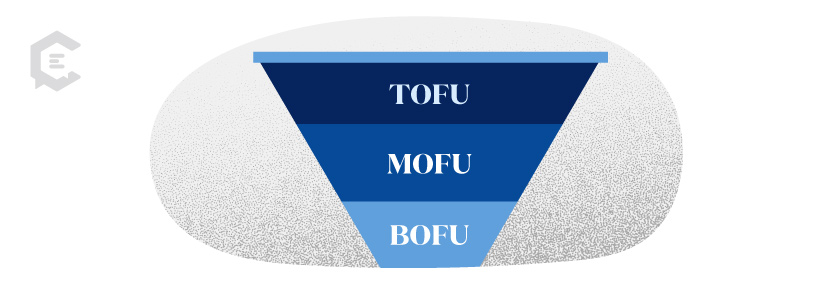In content marketing, you can’t just cast a wide net and hope for the best. You need to take a more strategic approach and craft content that guides potential customers through each step of the decision-making process.
In this comprehensive guide, we’re going to deep dive into the buyer’s journey. We’ll explore what it is, what its stages are, and what content you need for each stage. Let’s dive in.

What is the Buyer’s Journey?
Simply put, the buyer’s journey is a map of behavioral scenarios fueled by data. Feedback from analytics tools sheds light on where, why, and how customers land on your websites or social media feeds. Tracing these pathways and understanding how they connect and intersect forms the basis for a documented customer journey. Then, you can create a closed-loop marketing strategy that involves analyzing data throughout the journey to make data-backed decisions.
At a deeper glance, HubSpot defines the buyer’s journey, also known as the customer’s journey, as “the process buyers go through to become aware of, consider and evaluate, and decide to purchase a new product or service.”
This three-step process lays the foundation for a variety of customer journey variants.
- Awareness stage (TOFU): This is when your customers search for topics related to a challenge, goal, or opportunity to educate themselves. As a marketer, you can dig into the data related to this step to discover common concerns and how potential buyers prioritize their needs.
- Consideration stage (MOFU): In the second phase of interaction with your brand, the customer is armed with clearly defined goals and is ready to address them head-on. They are looking for targeted solutions. As a marketer, you can learn which categories of products/services your customers need most and what details they’re seeking about these solutions.
- Decision stage (BOFU): In this final touchpoint before making a sale, your customer is ready to commit. They’re weighing their options and choices before pressing the Buy Now button. As a marketer, you can discover how buyers evaluate your solutions, what concerns/expectations they may have, and who was involved in the decision-making process.
Despite a misconception that it’s always a top-of-funnel tactic, content marketing can help reach people at any stage of the funnel. As those people continue their interactions with your organization, it helps widen the neck of the funnel farther down. And because content is all the words and pictures on (and off of) your site, you have many options to tailor your content marketing message to where your audience is in that funnel. — Moz
Variations of the Buyer’s Journey
Absolutely. The order, types, and number of stages in a buyer’s journey vary based on your goals linked to specific campaigns, products, services, or customer types.
Think of a working funnel like an ice cream sundae. All are served in a tall vessel filled with scoops of ice cream topped with sweet treats. Some have sprinkles, whipped cream, cherries, and nuts. Others do not.
Variations of the customer journey can show up at any stage (the sundae toppings) within the foundational funnel (ice cream) we shared earlier. Why? That allows marketers to pivot and sweeten the deal with their audience at the ideal time, with targeted content to entice them to the BOFU. The right outreach is like finding an extra cherry under the second scoop of vanilla deliciousness. Perfect!
Let’s explore some popular stages and variants you might include in a customer journey mapping session.
Stages
Most funnels will include three to six of these stages:
- Awareness
- Differentiation
- Interest
- Desire
- Experience
- Capture
- Consideration
- Conversion
- Loyalty
- Partner
- Intent
- Evaluation
- Particulars
- Commitment
- Decision
- Action
- Retention
- Purchase
- Nurture
- Convert
- Transaction
- Repeat
- Advocacy
Variants
How the stages fit together and flow is determined by your unique sales process and goals from start to finish. The customizable combinations are endless.
Salesforce explains that taking the time to map out your buyer’s journey and find the variant that works best helps:
- Learn where and how customers engage with your outreach
- Fine-tune how to solve customer needs at various stages in the marketing funnel
- See if the order of the stages are indeed aligned to meet your goals
- Shows the sales team the approach you’re taking to generate leads for them
- Discover gaps in your sales cycle
- Find out where to concentrate your efforts to maximize ROI
Above all, does your customer journey align with your branding strategy? Is your outreach jiving with your values and as a company and how you want to present your brand? As you map out your ideal customer journey, you’ll want to think about content that partners with each stage of the funnel and the challenges of your specific customers.
Content for the Buyer’s Journey
A salesperson in a brick-and-mortar store wouldn’t dream of waiting to first approach a customer as they walk to the sales counter with their purchase in hand. Why do it online? This means it’s a good idea to be in front of your audience and speaking to them with your content marketing assets as early as possible, especially at the TOFU.
HubSpot shares that 88 percent of B2B marketers are using custom content to engage with their customers at various stages in their marketing funnels. However, 65 percent are confused about which types of content are most effective. When it comes to content creation, they recommend leaning into SEO optimized, high-value written content, such as blog posts, ebooks, reports and white papers filled with original research. More on that later.
Using buyer personas to create your content
Audience is everything. If you don’t know who you’re talking to, why are you speaking at all? Let’s explore ideal customer profiles and buyer personas as a way to ensure your content speaks to the customers flowing through your funnel.
An ideal customer profile (ICP) is a data-driven strategy tool that clearly defines your best-fit buyer, which is used to align your marketing and sale teams, according to the folks at Hull, a consumer data collection platform. ICPs lay the groundwork for successful personalized messaging and razor-focused campaigns that speak to a specific audience.
After you discover who you’re creating content for via ICPs, learn how to talk to these people as individuals. We do this by creating buyer personas, or fictional character vignettes that represent a specific category of your audience. They often read like an old-school yearbook bio with lists of hobbies and mentions of personal values. These warm and inviting character sketches help marketers get into the minds of their audience members.
Buyer persona checklist
There’s no industry-standard template (but, we love this B2B option) or list of attributes that a buyer persona must have, but they tend to include a handful (or more) of these bits of information, often arranged in a visually pleasing one-sheet/one-slide format tucked inside a branding strategy document.
- Name: These are usually cute and stylized. Think of monikers such as Healthy Hailey for a new protein powder campaign or CEO Sarah for a top-level executive buyer.
- Occupation: This includes job title, size of business and any other pertinent information that may have an effect on them as a buyer, such as income level.
- Goals: These may be personal life goals or professional goals. Some personas share a combination of both.
- Challenges: What pain points does your ideal buyer have? Detail them here.
- Demographics: Include the buyer persona’s age, geographical location and education level.
- Brands: On occasion, I’ve seen buyer personas include a list of products and services this fictional character loves to use. It gives marketers a peek at what branding already resonates.
- Social media: Where would you find this person hanging out online? How do they engage with these platforms? Do they rely on Facebook Events to stay looped in on weekend activities?
- Summary: This is a concise one to four-paragraph bio about the person and their daily life, work duties, concerns, ideals and why they might engage with the brand.
Content for Each Stage of the Buyer’s Journey
When you worked through your branding strategy, you likely discussed content levels. High levels bolster the core brand experience. Lower levels support strategy, branding, and function.
Since you know every buyer’s journey is unique with variants, let’s focus on the three general segments of the journey and what types of content assets best match buyers in these stages. As you browse, think about which of these aligns with the content levels identified in your branding strategy.
- TOFU: Inspirational/emotional blog posts, ebook offers, opt-ins, gated content offerings, tutorial videos, helpful social media posts, free online courses/certifications
- MOFU: Personalized engagement via email/calls/messaging, any content that positions your brand as an expert, webinars, guides, live chats, whitepapers, blog posts that offer a specific solution
- BOFU: Calls-to-action, trial offers, demos, downloads, case studies, product-focused content
HubSpot shares a few examples of content that align with the various stages in a marketing funnel. For top-of-funnel, we want to lead with sharable, enticing content that adds value to the reader’s life through education, freebies, or feel-good vibes.
When we get to the middle of the funnel, focus on qualifying your prospects and nurturing the relationships that were formed in the TOFU. Your audience is evaluating your messaging at this point, and you need to be ready to offer solutions before they discontinue their journey with you.
Finally, the bottom of the funnel is where you close the deal. Although your audience may not have made a purchasing decision yet, they’re ready to be swayed with a compelling offer that not only solves their needs but also solidifies their relationship with your brand.
Boost Your Buyer’s Journey Content
Building your content creation around the buyer’s journey ensures that you’re guiding your target audience every step of the way. That nurturing generates more leads and increases conversions, driving your brand’s growth and success.
If you’re looking for expertise and support when it comes to that creation, ClearVoice has you covered. Our expert teams will help you produce high-quality content that engages your audience at every stage of their journey. Talk to a strategist today to discover how.






